Paul Salamoff. You may not know his name, but you definitely know his work. He’s been a fixture in the film industry for almost 30 years, perhaps known best for his contributions to special effects and special effects make-up in films like “Batman & Robin”, “Shallow Hal”, and “Secondhand Lions”, and television series like “Land of the Lost”. He has also contributed to the visual effects in “Starship Troopers 3”, among others. But Paul doesn’t stop there. He is also a writer. As a novelist, his short stories have been included in horror anthologies, garnering him acclaim as a two-time Bram Stoker Award Nominee. He has written graphic novels, among them, “Logan’s Run” and “Discord” as well as issues of “Vincent Price Presents.” He is also the author of “On The Set: The Hidden Rules of Movie Making Etiquette.” And then there are his talents as a screenwriter on projects such as “The Dead Hate The Living”, “The St. Francisville Experiment” and “Alien Siege” for the SyFy channel. And did I mention he is also a producer? And how about his stewardship with The Academy of Science-Fiction, Fantasy & Horror Films for over twelve years, and his multi-year producing of the Saturn Awards. With all of this, one would think PAUL SALAMOFF has done it all. Well, not quite. It took a while, but he finally turned his attention to directing and now brings us his narrative feature directorial debut with ENCOUNTER.
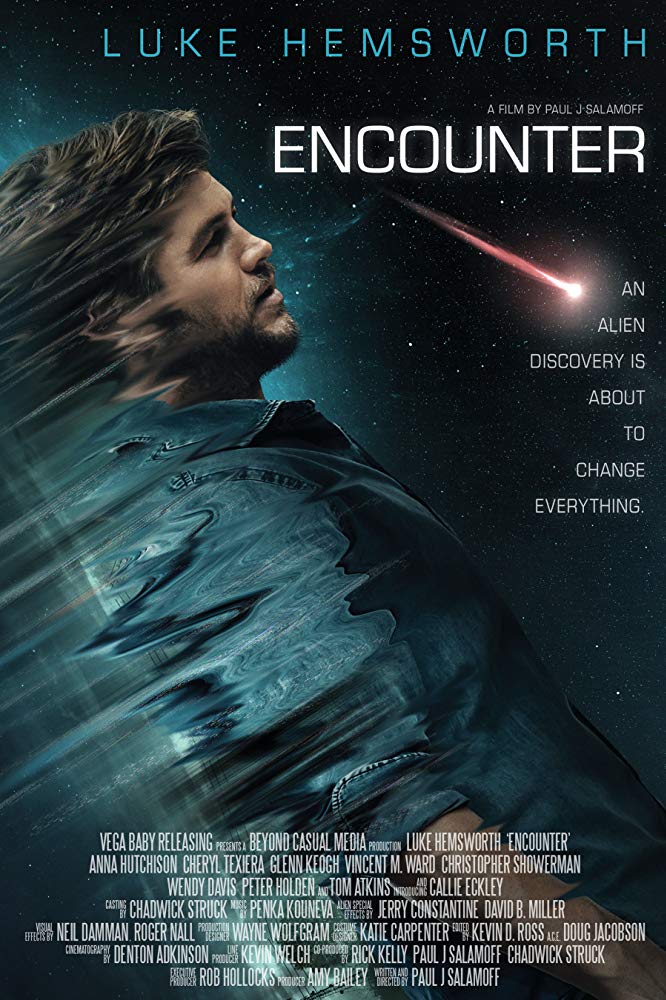
An admitted “sci-fi nerd”, ENCOUNTER is an engrossing science-fiction drama written and directed by Salamoff and is the story of a Will, a man disabled as the result of an accident which not only left him in a wheelchair but took his daughter from him and destroyed his marriage. Unfortunately, Will’s disability goes beyond the physical and into the emotional. Closing himself off from the world, he is trapped within himself, his memories, and spends all of his time disappearing into painting pictures of his daughter from memory. He has a supportive group of friends, but even they can only provide so much support, so much comfort, especially when Will is not receptive to it. On one particular night, while Will is cloistered in his garage studio painting, his friends Brent, Marcus, and Jonathan head out for a night under the stars drinking, talking, and lamenting life.
But everything changes when they see a glowing object shoot through the inky night sky and land in a nearby field. Intrigued, and despite being adults find the little boy inside each of them looking for adventure, they head off to find the object. Doesn’t take long before this oversized pinecone looking pod thing is found ablaze in a local wheat field. And, of course, just like picking up marbles and frogs and taking them home as souvenirs as kids, they decide to take this “thing”, probably a meteor, home with them. But once home, all that adventure and curiosity takes a backseat to fear with everyone. . .except for Will. . . and some federal agents who also witnessed the streak across the sky.
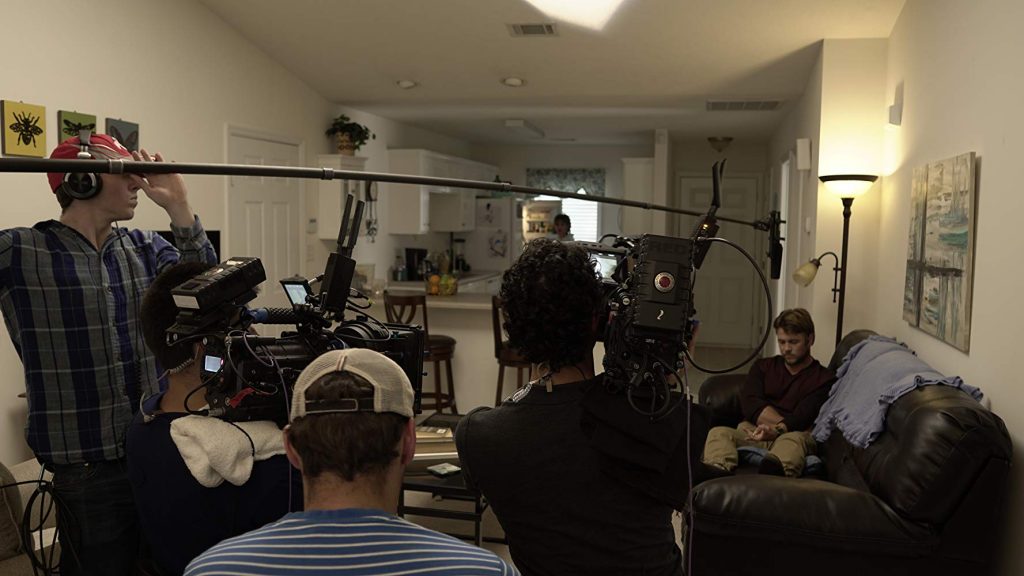
Starring Luke Hemsworth, Anna Hutchinson, Cheryl Texiera, Glenn Keogh, Vincent Ward, Chris Showerman, and veteran actor Tom Atkins, with ENCOUNTER, Salamoff delves into some difficult and challenging themes that present compelling and thought-provoking philosophical topics for discussion. Presenting some interesting character studies, most notably with Chris Showerman’s Jonathan and Luke Hemsworth’s Will, Salmoff keenly brings those themes to life visually through color, framing, and some good old-fashioned practical effects filmmaking.
What comes through loud and clear when speaking with PAUL SALAMOFF is his enthusiasm, excitement, and passion not only for the craft of filmmaking, but storytelling, and the ability to use all the tools in the cinematic toolbox to bring the story to life. His ideas on theme and character are strong and thanks to his skill set, he knows how to translate those ideas to visuals.
Going in-depth with Paul during our own lengthy telephonic encounter, we talked all things ENCOUNTER. . .
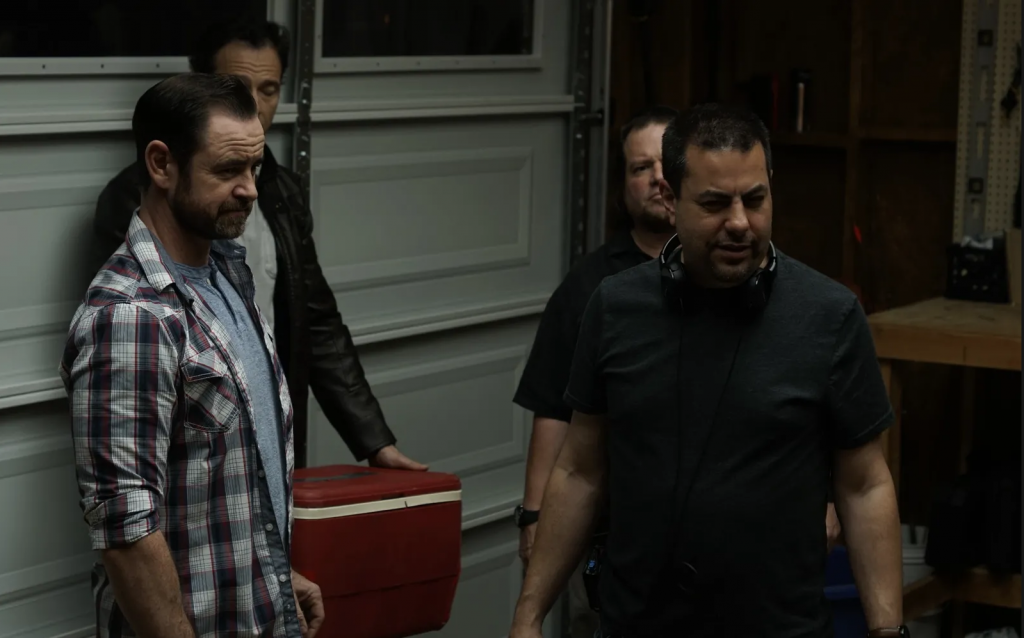
Well, Paul, what can I say? You are truly a jack of all trades! All the work that you’ve been doing over the years. All your FX work, your VFX, your SFX, your SFX makeup, it all comes to fruition here with the story you’re telling with ENCOUNTER. I am fascinated by this story to begin with. The philosophical aspects of this are compelling and thought-provoking. For me, it really feels something like Brit Marling’s “Another Earth.”
Thank you. Yes. Good, good! That was actually one of the inspirations.
You go to places where [Brit] and her partner go to in their projects, and I really like that. And we get to stew and simmer up until those last 10, 15 minutes of the film, and then the film ends and you’re like, “Oh my God!” Then you think even harder. I love when a film does that and makes you think and you do that so well here. So I’m curious, where did this story come from? This is definitely an out of the box story.
Thank you. You know what’s really funny? I’ve actually described myself as a writer, like try to think out of the box and stuff like that, so I always try to approach genre a little bit from the left, you know what I mean? Just from the side, because I’ve seen so many movies. Especially sci-fi. Since I was five years old when I was sort of obsessed with “Star Wars” and “Logan’s Run” and then “Doctor Who”, I’ve just seen so much science fiction. So I like to find things that surprise me and sort of approach that from different angles. So this one came out of, if I’m being really honest, it came out of a painful divorce recently where the rug was sort of pulled out from under my life. I wanted to tell a story that dealt with loss, and grief, and sort of this fear of the unknown. I had written a treatment for ENCOUNTER years ago. It was in my little notebook of ideas. And when I was given the opportunity to direct a film and told, “Hey, just find something you can do for a lower budget”, I pulled that out and was like, “Wow! This story still has viability and I could explore those themes in it.” So that’s really where that was sort of born from. The script just came out of me. The first draft was written in a very short period of time. It was something I sort of needed to deal with, like cathartically.
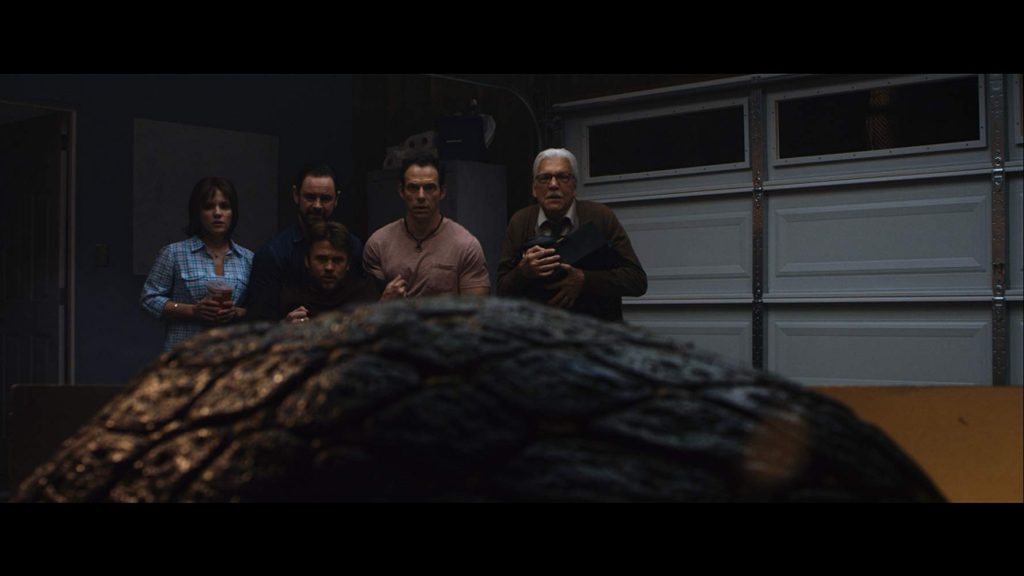
I love that you tackle these issues like grief, like loss, like fear, fear of the unknown, and you present it through your characters, an eclectic blend of characters, and each has their own sense of loss or grief or fear. So it’s not just the obvious with the character of Will. It breaks down into everybody. They’re all petrified of the unknown, of finding whatever this is in the field. And it’s like, “Oh my God, it’s going to eat us alive!” They weren’t so afraid not to pick it up, take it and throw it in the beer cooler and bring it back to the house. But dump it out of the beer cooler and then you have what looks like an overgrown pine cone and all of a sudden it’s, “Don’t go near it, don’t go near it!”
I really appreciate you saying that about the idea of loss because that’s the thing. They all do represent loss in different ways. Absolutely. And it’s not just because a lot of people are just glum and Will, because he’s the most obvious one. The thing is, like with Teresa. Teresa’s got this loss of self-esteem because she’s been browbeaten her entire life, had an abusive father and, her husband who’s not physically abusive to her, but is emotionally a little bit. Brent, who’s not a bad guy but he’s got this loss like he feels emasculated because he’s physically lost his job. So he is, unfortunately, lashing out at the one person who’s there to help him. He’s not physically abusive to Teresa; he does love her and care about her, respect her. But he’s so lost because he feels so emasculated that he’s let her down. And unfortunately [in] human nature sometimes we lash out at the people we care about.
Very much so. Brent’s in an identity crisis mode. And then, of course, you’ve got Marcus who as we learn very quickly, he faces the loss of a football career.
So there’s that, but it’s really a crisis of faith. That’s the physical manifestation of the fact that he’d lost his career and his future. But the thing is that for him, he has certain beliefs and this flies in the face of everything he believes in. So it’s sort of having this crisis of faith that’s sort of that loss, that crisis.
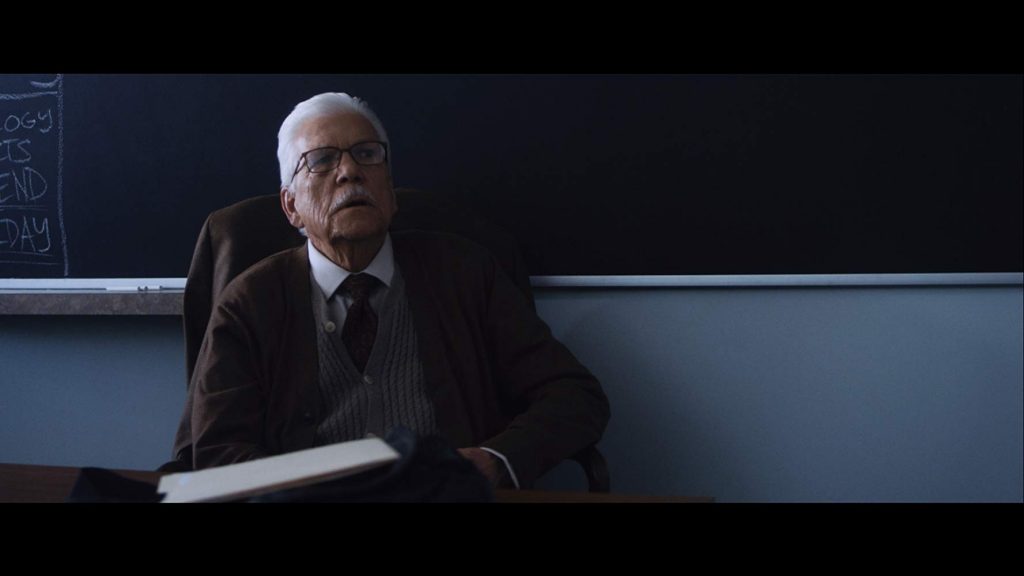
Then, of course, Jonathan, who I think is a very interesting character study. He’s very interesting because he comes across as being the flippant “Mister Party Hearty” of the group, and then he’s petrified, and then you slowly learn a little bit more about him, especially when you put him with Professor Westlake who is brilliantly played by Tom Atkins.
Thank you. Tom won Best Supporting Actor in Miami at the Miami Sci-Fi Film Festival. He won Best Supporting Actor.
Tom has such a career and he’s always so good and solid and strong.
It was so funny with Tom. He said to me, because he adores this movie, he loves this, when he read the script he just absolutely wanted to do it. He decided right away. But the funny thing was he goes, “I’m so used to playing like the bad [guy], the tough guy. I’m not used to playing the nice guy.” And the greatest thing about Tom is he’s a beautiful human being. He is literally. I love him so much. I really do. I’m really excited again going out with him. I was grabbing dinner and I’m going to one of his new movies next week because he’s going to be in town. And he’s just such a wonderful person in such a very supportive and very warm way. And he really loved this movie and he really loved playing Professor Westlake.
That dynamic you have with the character Jonathan and Westlake is really telling. That is one of the most interesting character dynamics you have beyond Will and whatever this creature is.
The thing with John is that John is the one who’s the most lost. He is just lost. He peaked in high school. He’s one of those people who sort of peaked in high school and he just can’t hold down a job. He can’t hold down a girlfriend. He’s sort of like this arrested development and he’s not prepared mentally to deal with what’s going on. And it’s funny; a lot of people aren’t really paying attention to what’s being said in the opening scene with them. I actually have some reviews where they dismiss that opening sequence. There’s a bunch of like “local yokels just chatting about nothing,” They’re not chatting about nothing. The girl John is talking about, Rachel, that’s the girl later on at the bar. It’s an important thing about their relationship. It informs a lot about him. So I’m sort of setting her up in that opening scene. But, a lot times in an opening scene you just think they’re just talking about nothing, but they’re not. Everything they talk about in that opening scene actually has relevance to the rest of the movie. It’s just out of context.
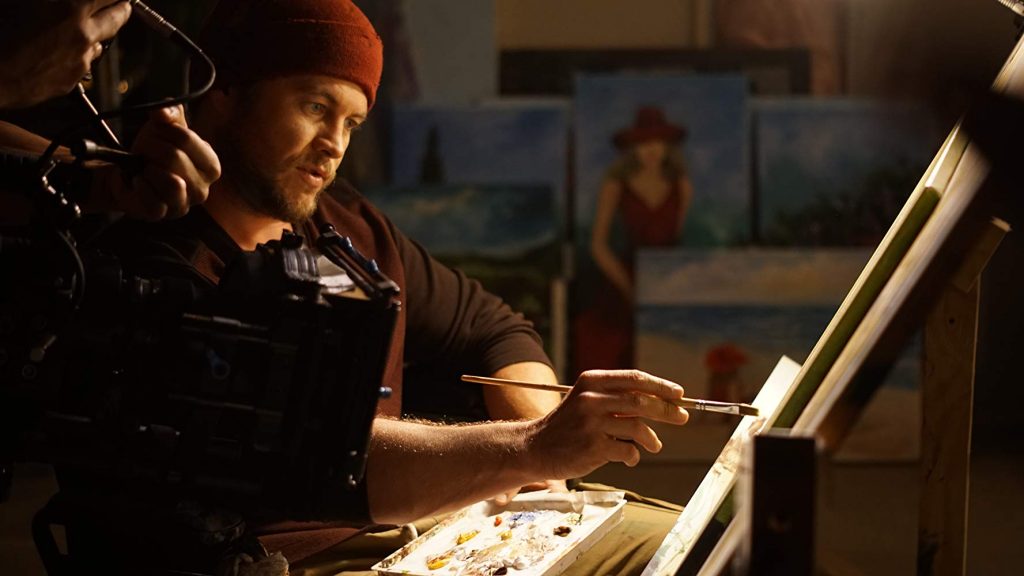
When it comes to Will and the creature that’s where your really strong emotionality is. And watching this, because here he is and it’s essentially a sentient being of some sort that he is bonding with, communicating with. And we go on that journey as to how he ended up in a wheelchair, why he is in such a bad mental state. And it’s through that connection. He can’t articulate this with anybody else because it’s like, “Snap out of it.” It’s the Moonstruck moment where everybody wants to just slap him and say, “Snap out of it.”
Yeah! “Snap out of it.” I know exactly what you’re saying. I love that movie, by the way. I worked at a movie theater when I was younger and “Moonstruck” played. I think I saw “Moonstruck” six or seven times, so I know exactly what you’re talking about. Snap out of it!
But that’s how everyone treats him. And Luke Hemsworth as Will? I adore Luke. I’ve interviewed him multiple times in the past and I think he’s the unsung Hemsworth brother.
Yes! When we did a Q&A the other day he sort of made self-deprecating remarks that he’s the “other” Hemsworth. And I’m like, “Dude, you’re like THE Hemsworth they should be paying attention to.” He’s the real deal. He’s a really solid actor in the way he approaches material, in the way he discusses it. We talked about this character a lot and we got to rehearse a lot before we actually went and shot the film. Every time I watch the film you see how much he put himself in there. And he did a lot of stuff. One of the things he did was he purposely didn’t talk to his wife and kids while we were shooting the movie in order to get him in that emotional state where he would be missing that. And it was really hard for him. He obviously talked to his wife about this and it wasn’t just like, “Hey, I’m just not going to talk to my kids.” It was just done perfectly so he could really get into that emotional state. Obviously no spoilers, but when you get into that final act, it’s really emotional. It was emotional for me trying to direct the movie because this was obviously my dealing with some of my demons and that was hard. That third act was hard to shoot.

I think a big part of what makes Luke so strong in this role, and in other roles he’s done, such as in ” Kill Me Three Times” or even in “Hickok”, is that he’s worked the stage doing theatre work Down Under and I really think that gives you a much better understanding of connection than just jumping into a film or TV role. It really comes out here with what we see Luke bring. He and your alien become the heart of this film.
One of the things I said on set all the time to the actors was, “Look, I know there’s all this weird stuff, and tether coming out of his neck and there’s creature effects and stuff like that. We’re making a drama. We’re making “Manchester By The Sea.” We’re not making a sci-fi movie. I want you to keep that reality because if you don’t stay in reality, this will not work. The minute this feels camp, we’re done.” And I was very aware that I’m really pushing the boundaries of what people might feel comfortable with, especially with the tether. I’m a big fan of David Cronenberg and Clive Barker, but, because [Will] deals with sort of like body dysmorphia and weird unusual stuff, I just wanted to just embrace that even though I know it might be challenging for some audiences, it might be a little too “ick-factor” or whatever. I wanted the actors just to stay in that reality. What would happen? How would you react to this if this was it really happening? That’s why my favorite scene is when they pulled Will out for the first time in that scene in the living room. I tried to construct that so I’m letting the actors say all the stuff the audience is thinking right now; letting the audience off the hook. The last thing you want is that you don’t want the audience like, “Well come on, they would be asking this or they would be asking that.” And we’re going to address all on that.
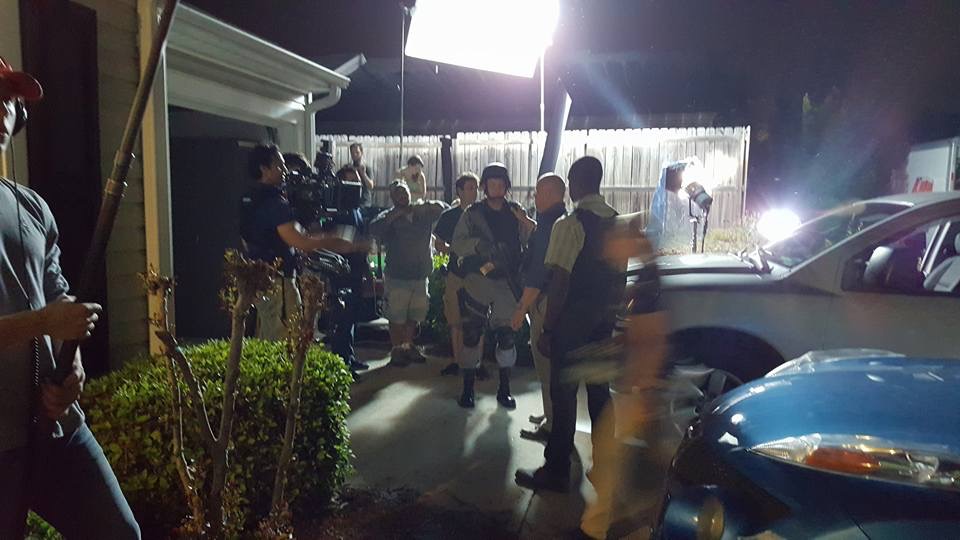
A big part of the connectability and the resonance with the character of Will and the alien is the actual alien itself, and your construction of that in its various forms. I love how it changes. It morphs. The more it connects with Will or with Teresa, it grows. And I think that’s really a fascinating aspect. But I’m curious, given your background and then with your alien creature creators, Jerry [Constantine] and Neil [Damman], and David Miller whom you brought on board, how did you go about designing the look and the applications and traits of this creature?
When I sat down with Jerry Constantine, who I’ve known for a really long time, he’s my go-to guy, I said to him, “Look…” In the dream, I want people when they see a still for my movie, that the thing can be so iconic that you know it’s from ENCOUNTER. There’s a certain simplicity in design as well. But I said, “I don’t want it to be anthropomorphized. I don’t want it to have a mouth. I don’t want it to have eyes. I don’t want to have anything recognizable of any kind of traits we can understand. That it’s supposed to be beyond sort of our understanding to a certain extent.” And even as it changes, it becomes almost unrecognizable in each variation. It sort of builds on itself. And I wanted to use unusual colors like purples and oranges, which aren’t really typical colors, because it’s supposed to represent alien. When I say alien, not H.R. Giger’s [works]. I mean just alien. This is an alien thing and not of this world. [ I don’t want to] over-explain it. I know exactly what it’s doing.
There are rules that I completely understand that I do not explain to the audience. I love European filmmaking in the sense of you don’t need to over-explain. Where you over-explain stuff, I think it really takes a layer off the movie. I know exactly what this thing is doing. Exactly. But it wasn’t necessary to explain; only to sort of hint at it or sort of throw those questions out there for the audience to sort of decide. Even the end of the movie, no spoilers, you can decide whether you just saw something beautiful or you just saw something horrifying. It’s your interpretation of the ending. Obviously the story has a definitive ending but there’s a certain ambiguity to it as well. It’s for you to decide. There are some questions that are posed that might be the truth. And then some other question then might be the truth too. I wanted to lead that open ending. I wanted it to haunt you and make you think about it. So that was a whole approach to the design and knowing that we were on such a limited budget it really was only supposed to be about 12 digital effects. The best effects in movies are practical effects enhanced visually. I got lucky with Neil Damman because he really just loved the movie so much. He was working, I think, on “Solo” at the time. He was doing fine with how much he was making on those movies but he was like, “You know what? This is on the side. I’m going to help you out on this and don’t worry about so much about how much this is costing. I’m going to work within your budget.” And just really went above and beyond. We wound up having over 114 digital effects shots. And they’re all 2D effects because we couldn’t afford 3D effects. So it’s all 2D stuff. Just enhancements. Even all those transformations when [the alien] is getting bigger and growing, that’s all practical. There’s no digital effects there. I would sit with my cameramen and crew and say, “You got to trust me on this.” I did effects for 14 years, as I mentioned. And I would hold the camera here and I would just roll the thing in front of the camera. I would just do this little close-up and push it this way. It’ll give the illusion when it’s edited, it’ll give the illusion that it’s growing. There were no growing rigs. There was one thing we had and that was a rubber piece that we could stretch and move around. But other than that, it was all just illusion. Just illusion. It’s knowing how to use practical effects properly and filming them properly. So you’re basically tricking the audience into thinking they’re seeing something. But it never grows. There’s no growing in any of these.
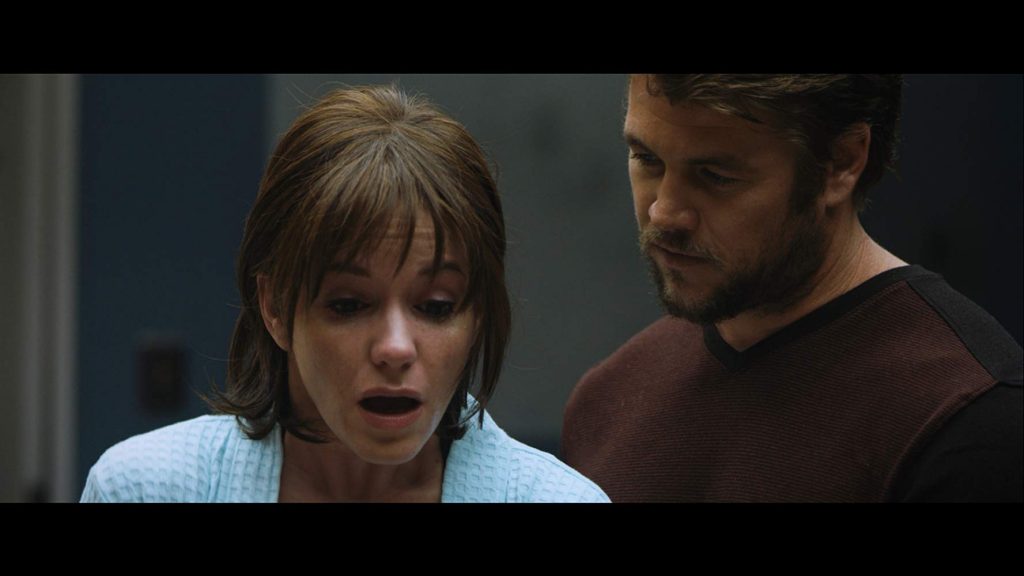
It’s all about the POV and how you’re angling it. Talk to me about working with your DP, with Denton Adkinson. Did you guys storyboard? Given your background I would think you could go either way – storyboard or shot list or both. What were your considerations, especially with your lighting? I have to say the garage, when we first see Will in the garage and he’s painting, the visual tonal bandwidth of that scene is absolutely beautiful. The lighting is gorgeous and similarly, it ties perfectly to the guys out in the field. That inky black night, and then you see when they get to the field and we see the streak in the sky as the thing falls to the ground. Wheat is burning and it’s got a beautiful glow in it. It’s analogous to the glow that Will feels when he’s sitting there painting in the garage.
Oh my gosh!! Can I tell you something? You really got this movie. You really got it. Thank you so much for asking these questions. I got to tell you, this is one of the best interviews I’ve ever had ever about any of my projects! You got this and you’re actually getting the stuff that was there that I thought would be invisible, that people wouldn’t pick up on, maybe just on a subtextual level. But before we talk about storyboards, let me gush a moment about Denton Adkinson, my DP. Now he’s somebody! We did this in Augusta, Georgia and I wanted to do this primarily with an Augusta crew. Denton was sort of like “the” DP down there. I think I met him briefly before because I’ve been helping them grow their film community for awhile. But I was basically told, and in no uncertain terms, “By the way, if you’re going to make this movie, you’re going to use Denton as the DP.” And I’m like, “All right.” He seemed like a nice guy. So Denton and I got to know each other and just sort of talk to each other a little bit. And we just bonded. He’s like a brother to me now. And I’m telling you, what he brought to the movie is… I don’t want to do a movie without him. There’s actually two people I fight for. I’ve been offered some other movies, and I’m like, “There’s two people I’m not going to work without. And that’s Denton, my DP, and Panka Kounera, my composer.” And with Denton, we really talked about the color and the use of color in this movie; the amber that’s in the garage which, by the way, was a set. That was actually a set we built. The amber, and that’s what it was, it was that glow, that bubble that [Will] had sort of created for himself. And by the way, there was very little color correction in that scene. We had a great colorist on the movie. But there was very little color correction because the lighting of it was so perfect. Every character, like the agents, had their own color palettes. Luke’s character of Will had his own color palette. And also if you notice in the opening shot of the butterfly, which obviously has significance, it goes from being very rich but as it goes down that trench, the color starts to drain out to that steel gray which represents the agents. And as the movie goes on the colors become a little bit more vibrant. The oranges become more orange. So there was that thing of despair kind of leading towards hope. There was definitely that thing that we were leading that. So the way you described the amber, that was his little collective bubble. But when that bubble bursts, it becomes a little bit colder when the two worlds encroach into Will’s life.

And of course, you also pick up that color in the alien. As the bubble in the garage bursts, that color is then transferred as the alien is pulsing. So that between each of its scales or whatever it’s covered with, then we see that color again. So it doesn’t disappear. Ever.
Yep. Yeah. I don’t want to [say] too much, but it represents hope. That’s one of the other themes in this movie, is hope. So that was representative of the color, like orange. Another thing is the storyboards. So that’s a great question. And here’s the thing. I can’t draw to save my life. But I definitely wanted to storyboard this movie because this is the first time I was directing a movie and there was no way I was going to screw this up. I wanted to be prepared. Because this is the one chance I’ve got, I’d better make the best movie that I can with the resources that I have. I have this program called Frame Forge 3D, which is like a previs kind of program that I’ve gotten really good at. I’ve done storyboards for other people and other things with it. I wound up storyboarding the entire movie with over 1400 storyboards. The one thing that was really amazing about it was that I was able to have my actors come over to my house. My office is really crazy. It’s the toys everywhere and models. I own the Tardis console from the 1996 “Doctor Who” TV movie. That’s in my office. And I have a movie theater sort of in my office.
So I sat everybody down and I showed them the entire movie as an animatic, basically, before we shot a single frame. One of the actors said “This is a gift. This is absolutely a gift.” Because they saw the movie. I just sort of walked them through it. On the Blu-ray, there’s a storyboard to film comparison. You can really see how similar it is. I wasn’t tied to these on set, but I had already conceived the movie in my head. So this was the movie in my head. I didn’t use shot lists. I tried to use a shot list on the first day and I just couldn’t wrap my brain around it, so I wound up using the storyboards as my shot list. And you know what? We came in on schedule, under budget, and we never had a second meal during the 15-day shoot. I shot everything I wanted to shoot. Everybody on the crew, everybody, including the PA, got a copy of the storyboards. I wanted that. And we had them onset so everybody always had them. My assistant always had them next to me and when there was any question, I could just point to the storyboard and it’d be like, “Oh, I get it.” There’s obviously adjustments made on set and so forth, but it was such a great shorthand. I think that’s a mistake that a lot of people make; they keep so much stuff so close to the chest sometimes. You’ve got to realize that making a movie is such a collaborative experience and ego only gets in the way. I’m not ego-driven. I’m very creative-driven. So, we didn’t have a bad egg. We didn’t have anybody with an ego on the set, from the Executive Producer on down. Rob Hollocks is a great Executive Producer. And then my Producer Amy Bailey, it was her first film as a producer and she was the only producer on the film, and she knocked it out of the park because she understood that it’s not about causing problems, it’s about making sure everything runs smoothly. And it did. And we had a crew that really understood what we were making. Everybody on the set understood the movie we were making.
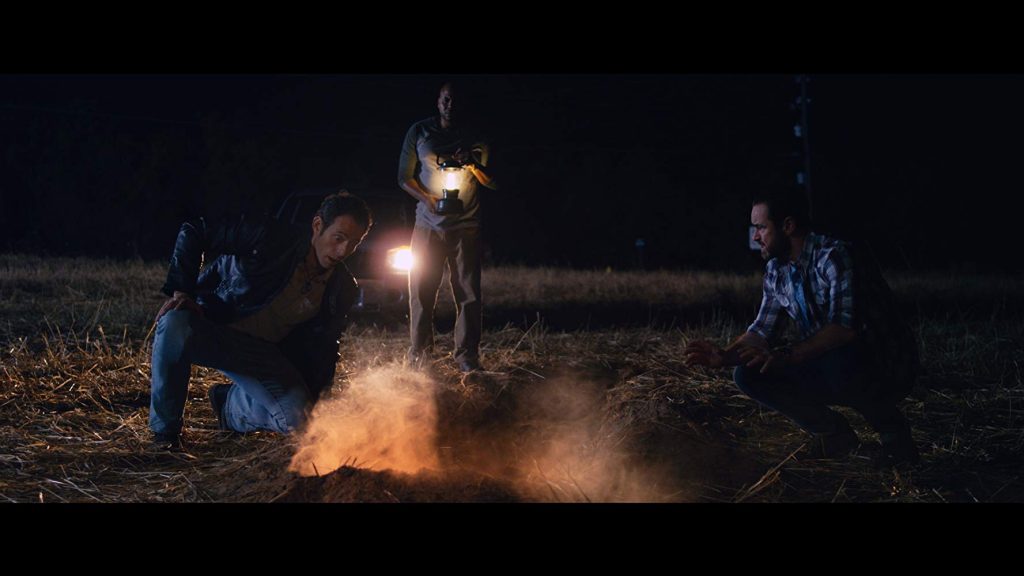
So I’ve got to ask you, Paul, what did you, now that your first feature is done, out there, and everybody gets to see it, what did you learn about yourself as a director that you will now take forward or can take forward into your future projects?
I learned a lot because here’s the interesting thing. I never fancied myself as a director. . .This was a very calculated thing about me directing the movie. I felt I was ready. But I’m a writer first. I’m a storyteller. . .People think I want to direct everything I write and that’s not true. I’m like, “I’ll leave that to the professionals.” I like the smaller stories that I’ve written. Those are the ones that I’m interested in directing and here’s what I learned. Make sure that you allow for those quiet moments. Every scene does not have to be driven by dialogue. We would shoot and before I would yell action for the actors, we would definitely have the cameras rolling. Even when the scene was over, we’d still let them run because the lovely thing about shooting on digital, we shot on the Red Dragon, is that you’re not worried about burning film. So we let the camera roll so we got those candid moments. And it was amazing to me when we got into the editorial!
It says that we had two editors on this. The first one, Doug Jacobson did a great job of assembling what the movie was, but it really took Kevin Ross, who was one of the Emmy nominated editors of “Stranger Things” to come in there and find that pacing, find those moments, those quiet moments. So that’s one of the things that I really can’t wait to bring to the next thing I direct. Movies don’t have to be about constant dialogue. They can be about those quiet, introspective moments, and it’s not boring. There’s that fear that, “Oh my God, if I don’t have something constantly always happening, the audience is going to get bored.” But the irony for me is that I’m a big fan of filmmakers like Andre Tarkovsky, whose [films] some people compare watching paint dry. But those are the movies I love. “Blade Runner” is my favorite movie of all time and that is a very evenly paced film. And I feel like the pacing for ENCOUNTER is that it’s a slow burn movie, but it moves at a good pacing. That’s a nice compliment I always get. Nobody’s bored by it. It doesn’t overstay its welcome. It’s 92 minutes and that’s the perfect length for it. It just chugs along. It takes its time, but it chugs along. And that for me was really important because sometimes 92 minutes can feel like an eternity. So that’s really the real thing I learned.
Also, be proud of yourself and to know that you are capable of doing things. Trust yourself and your instincts. There were times on set where I’m literally like, “Okay, you guys got to trust me on this. I’m promising you this is going to work. I just know it’s going to work.” And then just go for it. So I’m really excited on the next one to really start pushing the boundaries of what will hopefully become my signatures. The three biggest influences on this were David Cronenberg, Denis Villeneuve, and Atom Egoyan. I’m a big fan of “The Sweet Hereafter” and “Exotica”. Actually, most of his movies. I love the way he deals with drama and the way he deals with characters. And so to bring that kind of feel to it, but with my own voice. So I’m finding my voice and I’m feeling it, and I’m excited to explore that in whatever I do next, to really start pushing the boundaries of visual storytelling because at the end of the day, when you’re directing a movie, it’s a visual storytelling.
by debbie elias, exclusive interview 10/03/2019











